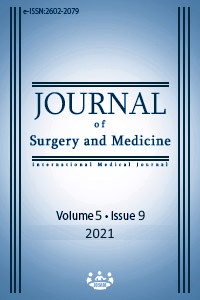The effect of online education during the pandemic on ocular surface symptoms
Keywords:
COVID-19, Online education, Tear break-up time, Schirmer, OSDIAbstract
Background/Aim: During the pandemic, eye symptoms increased. This study aimed to investigate the effects of online education on ocular surface symptoms, which was a part of the distance learning model during the COVID-19 pandemic, to be able to prevent the formation of irreversible damage. Methods: This cohort study included 315 students who were undertaking online education and presented at the Ophthalmology Department of a university hospital. The sociodemographic data, Schirmer test results, tear break-up time (TBUT) and Ocular Surface Disease Index (OSDI) scores of the students were noted. The data were analyzed using SPSS v. 22.0 software and a value of P<0.05 was considered statistically significant. Results: Evaluation was made of 315 students with a mean age of 14.48 (5.86) years (range: 6-29 years). Of these, 159 were studying at a high school or university, and 267 had been participating in online education for ≥6 hours per week. New symptoms had developed in the eyes of 213. The Schirmer test results were 8.74 (3.76) mm in the right eye and 8.90 (3.86) mm in the left eye. TBUT was 9.95(3.60) seconds in the right eye and 10.15 (3.58) seconds in the left. The mean OSDI score was 26.39 (11.85). OSDI was significantly negatively correlated with the Schirmer results and TBUT (r= -0.883, P<0.05, r= -0.793, P<0.05, respectively), while Schirmer and TBUT were positively correlated (r=0.871, P<0.05). Conclusion: With the continuation of education online during the COVID-19 pandemic, televisions, computers, and tablets were commonly used. This increased screen time led to the development of new symptoms causing significant changes in the OSDI, TBUT, and Schirmer tests.
Downloads
References
Malik YS, Kumar N, Sircar S, Kaushik R, Bhat S, Dhama K, et al. Coronavirus disease pandemic (COVID-19): challenges and a global perspective. Pathogens. 2020;9(7):519.
World Health Organization Coronavirus disease 2019 (COVID-19). Situation report - 81.
Lee SJ, Ward KP, Chang OD, Downing KM. Parenting activities and the transition to home-based education during the COVID-19 pandemic. Children and Youth Services Review. 2021;122:105585.
Seymour-Walsh AE, Bell A, Weber A, Smith T. Adapting to a new reality: COVID-19 coronavirus and online education in the health professions. Rural Remote Health. 2020 May;20(2):6000.
Paudel P. Online education: Benefits, challenges and strategies during and after COVID-19 in higher education. International Journal on Studies in Education. 2021;3(2):70-85.
Wong CW, Tsai A, Jonas JB, Ohno-Matsui K, Chen J, Ang M, et al. Digital Screen Time During the COVID-19 Pandemic: Risk for a Further Myopia Boom? Am J Ophthalmol. 2021 Mar;223:333-7.
Simavlı H, Önder Hİ, Bucak YY, Erdurmuş M, Güler E, Hepşen İF. Bilgisayar Kullanıcılarında Oküler Yüzey Hastalık İndeksi ile Kuru Göz Testleri ve Demografik Özellikler Arasındaki İlişki. Turkish Journal of Ophthalmology/Turk Oftalmoloji Dergisi. 2014;44(2).
Alvarez-Peregrina C, Sánchez-Tena MÁ, Martinez-Perez C, Villa-Collar C. The Relationship Between Screen and Outdoor Time With Rates of Myopia in Spanish Children. Front Public Health. 2020 Oct 14;8:560378.
Bahkir FA, Grandee SS. Impact of the COVID-19 lockdown on digital device-related ocular health. Indian J Ophthalmol. 2020 Nov;68(11):2378-83.
Bostancı B. Dijital Göz Yorgunluğu Sendromu ve Kuru Göz. MN Oftalmoloji 2016;23:96-9
Shantakumari N, Eldeeb R, Sreedharan J, Gopal K. Computer use and vision. related problems among university students in Ajman, United Arab Emirate. Annals of medical and health sciences research. 2014;4(2):258-63.
Schiffman RM, Christianson MD, Jacobsen G, Hirsch JD, Reis BL. Reliability and Validity of the Ocular Surface Disease Index. Archives of Ophthalmology. 2000;118(5):615-21.
Pang Y, Madro S. Effect of Screen time on Dry Eye Symptoms in Young Adults. Investigative Ophthalmology & Visual Science. 2020;61(7):341.
Mishra G. Impact of prolonged digital screens exposure on ocular surface and management. International Journal of Health and Clinical Research. 2021;4(3):136-8.
Mehra D, Galor A. Digital Screen Use and Dry Eye: A Review. Asia Pac J Ophthalmol (Phila). 2020 Dec;9(6):491-7.
Uchino M, Yokoi N, Uchino Y, Dogru M, Kawashima M, Komuro A, et al. Prevalence of dry eye disease and its risk factors in visual display terminal users: the Osaka study. Am J Ophthalmol. 2013 Oct;156(4):759-66.
Kawashima M, Sano K, Takechi S, Tsubota K. Impact of lifestyle intervention on dry eye disease in office workers: a randomized controlled trial. J Occup Health. 2018 Jul 25;60(4):281-8.
Yiğit U, Evcimen Y, Kırık F, Ağaçhan A. Kuru Göz Hastalarında Gözyaşı Osmolarite Ölçümünün Gün İçi Değişiklikleri. Turk J Ophthalmol. 2013;43:437-41.
Gümüş K, Arda H, Öner AÖ, Kaküçük S, Mirza E. Bilgisayar kullanımının kuru göz parametreleri üzerine olan etkisinin değerlendirilmesi. Türk Oftalmoloji Dergisi. 2009;39(4):244-9.
Balyen L. Bilgisayar Kullanıcılarında Oküler Yüzey Hastalığı İndeksi ve Kuru Göz Testi Parametreleri Arasındaki İlişkinin Değerlendirilmesi. Kafkas Tıp Bilimleri Dergisi. 2019;9(3):169-79.
Downloads
- 497 469
Published
Issue
Section
How to Cite
License
Copyright (c) 2021 Abdullah Beyoğlu, Muhammed Mustafa Beyoğlu
This work is licensed under a Creative Commons Attribution-NonCommercial-NoDerivatives 4.0 International License.
















